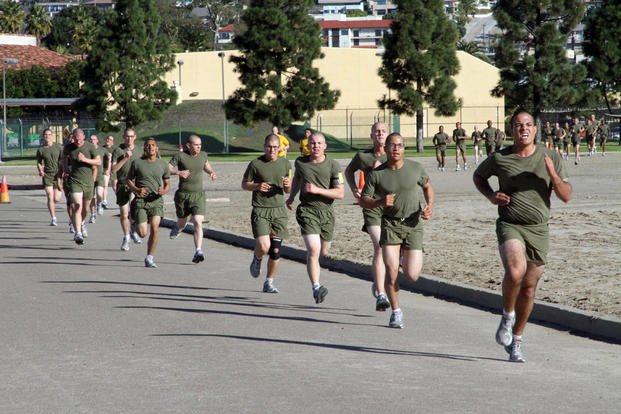Strong and powerful weightlifters have a leg up on the strength requirements needed when serving in the military. That doesn’t mean there won’t be significant weaknesses that need to be addressed before you are even eligible to join.
Here is a question from a powerlifting athlete who seeks to serve in the Marines or Army Rangers and is ready for a change.
Hi Stew, I wanted your advice on how I should prepare for either the Marines or Army Ranger training. I know the standards are high and I should try to emulate and train like the elite and not just meet the bare minimum requirements to serve.
However, I come from the powerlifting world and weigh 265 at 5’10'' and need to lose some mass before I can even come close to the required standards of endurance and muscle stamina. In your professional opinion, would you suggest that I focus solely on long distance type aerobic training for the next few cycles of training? Thanks for your time – Jeremy.
Jeremy, the weights that you can lift are likely to put you in the top 1% of the military, but your cardio endurance and muscle stamina likely will be in the bottom 10% as most power athletes suffer when they adopt the long-distance running metric that “anything over 100 meters is long distance.”
I have a laundry list of things for you to consider as you make this transition from powerlifting athlete to tactical athlete in a hard-charging unit, such as the Marines or Rangers.
1. Get Out of the Weight Room
It is true you need to lose some mass. For your height, that may mean significant amounts of fat and even some muscle. You will lose some powerlifting gains that resulted from your max one-rep lifts, but you will gain much more. For starters, focus on calisthenics and cardio exercise.
2. Run (Well, Not Yet)
Depending on what branch of service you select, you will need to get much better at running at a fast pace for 2-3 miles. The Army requires a two-mile run for its combat fitness test, and the Marine Corps requires a three-mile run for the physical fitness test. My advice is to focus on weight loss by spending most of your time walking, rucking and doing non-impact cardio activities, such as biking, rowing, swimming and the elliptical machine. These activities will help you avoid aches and pains, plus potential feet, shin, knee, lower back and tendon injuries that occur when people at your current weight start running too soon.
3. Upper/Lower Cardio and Mobility Splits
Use a split routine. On one day, you focus on building up the volume of repetitions in upper-body exercises (pull-ups, push-ups, crunches, plank pose, hanging knee-ups, etc.) The next day, do a combination of walking, running, rucking and leg day exercises, such as squats, lunges and stair climbs. The day after the two days of upper- and lower-body workouts, do a day of non-impact cardio and mobility work. See ideas in the articles Run, Bike and Leg PT and Upper Body PT Pyramid. We typically make our mobility and cardio days look like this:
Bike, row, elliptical or swim for 20-30 minutes as a warmup.
Repeat 5 times
Fast-paced kike or row or elliptical: 5 minutes.
Stretch and foam roll: 5 minutes.
Then cool down for another 20-30 minutes with either swimming or easy bike.
That is just three days of the week. Do them again on Thursday, Friday and Saturday. Rest on Sunday, but stretch and walk.
4. Caloric Deficit
At the end of the day, you will need to accumulate enough calories burned through work, workouts and supplemental cardio to burn off more than you consumed that day. If you are successful with your portion control and eat to lose weight, you will see the weight fall off. However, losing muscle is not easy; this has to be done with increased cardio activity and decreased food intake.
Finally, understand what you are getting into by choosing the Marines or Army Rangers. The Army has the new ACFT that will challenge you. Even though you can crush the strength component, you still need to do high-rep calisthenics and the two-mile timed run. Rangers will require you to complete a five-mile timed run in less than 40 minutes.
The Marines require pull-ups, which are harder for the heavier athlete, as well as crunches or a plank and a three-mile timed run.
Conditioning for these events will be critical. Even though you will be out of the weight room for a few cycles, you still will maintain significant strength compared to your peers. But strength and power are not the problem for you today. You must improve at the other elements of fitness required for the tactical athlete: speed, agility, muscle stamina, endurance, flexibility, mobility and grip. As long as your workouts address these elements of fitness each day, you are on the right track.
Stew Smith is a former Navy SEAL and fitness author certified as a Strength and Conditioning Specialist (CSCS) with the National Strength and Conditioning Association. Visit his Fitness eBook store if you’re looking to start a workout program to create a healthy lifestyle. Send your fitness questions to stew@stewsmith.com.
Want to Learn More About Military Life?
Whether you're thinking of joining the military, looking for fitness and basic training tips, or keeping up with military life and benefits, Military.com has you covered. Subscribe to Military.com to have military news, updates and resources delivered directly to your inbox.


















